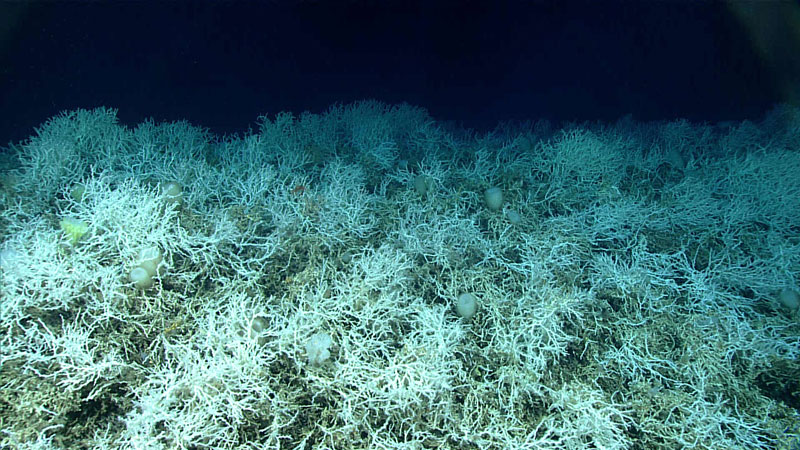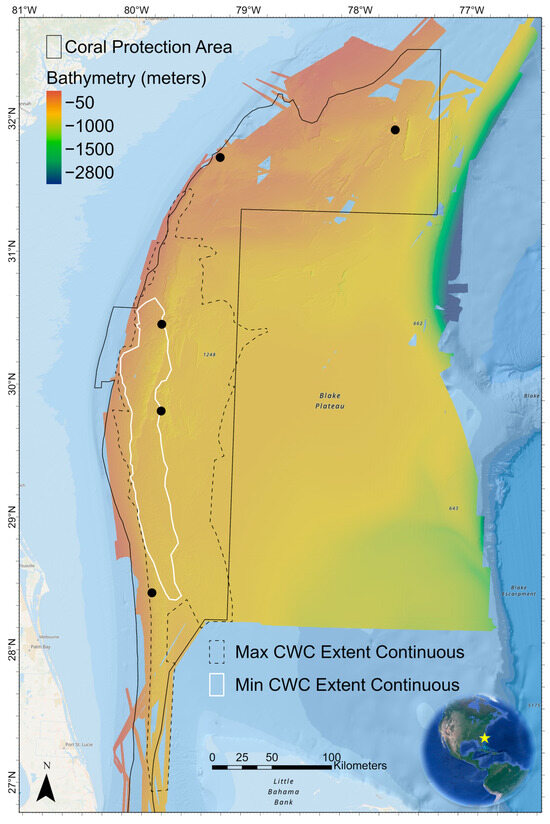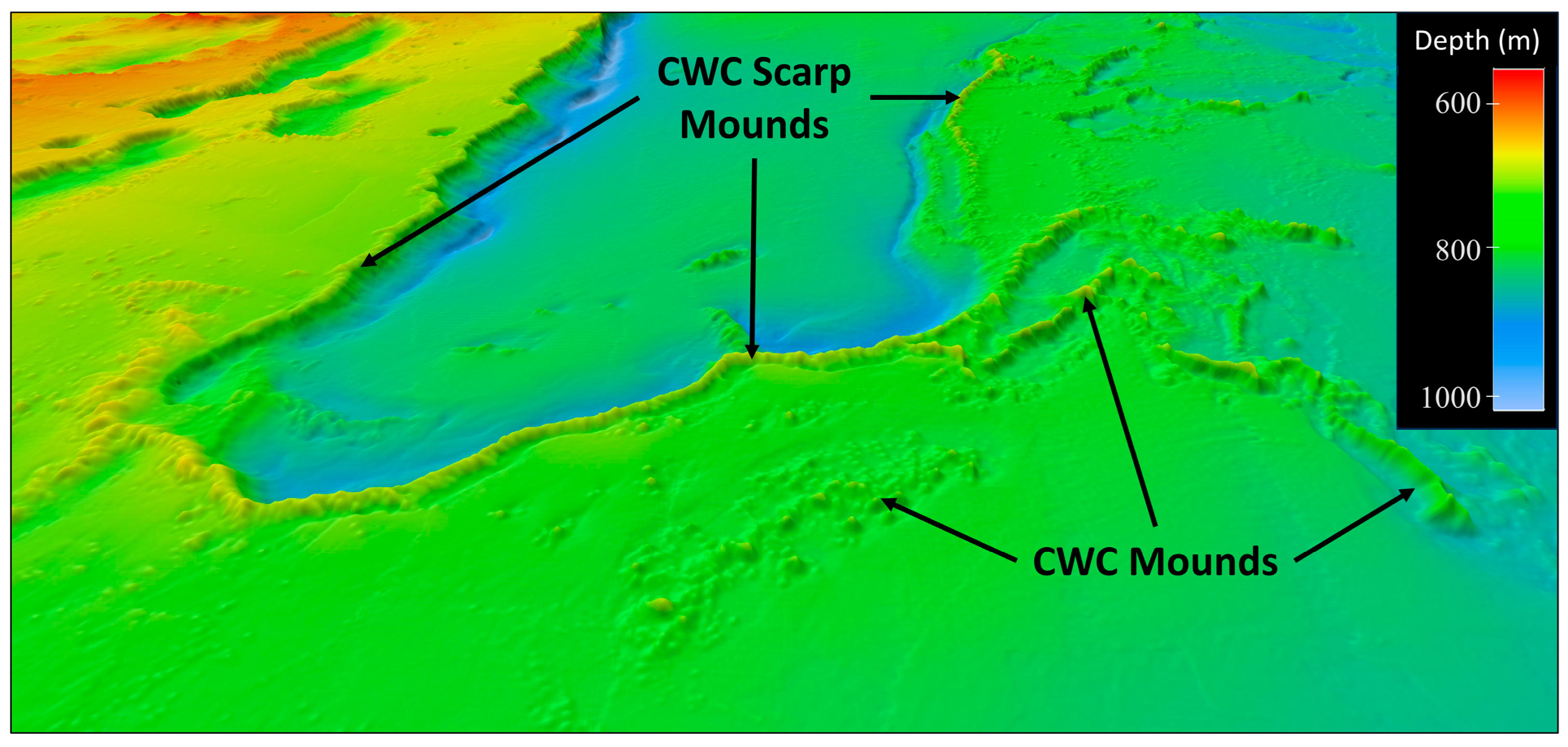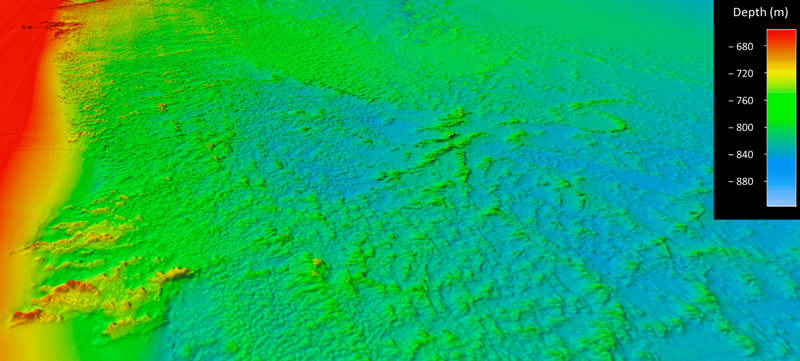Dense thickets of the reef-building coral Desmophyllum pertusum (previously called Lophelia pertusa) make up most of the deep-sea coral reef habitat found on the Blake Plateau in the Atlantic Ocean.
The white coloring is healthy – deep-sea corals don’t rely on symbiotic algae, so they can’t bleach. Images of these corals were taken during a 2019 expedition dive off the coast of Florida
Image courtesy of NOAA Ocean Exploration, Windows to the Deep 2019.
From NOAA
Covering 6.4 million acres, an area larger than Vermont, an underwater
seascape of cold-water coral mounds offshore the southeast United States
coast has been deemed the largest deep-sea coral reef habitat
discovered to date, according to a paper recently published in the scientific journal Geomatics.
Bathymetric terrain model synthesis grid of the Blake Plateau CWC mound
study region from 31 different multibeam sonar surveys.
The white
polygon represents the minimum extent core area of dense nearly
continuous CWC mound features in the largest CWC province on the
plateau.
The yellow star on the inset map represents the location of the
Blake Plateau adjacent to the southeast U.S. coastline.
The black
dotted line polygon represents the maximum extent of continuous CWC
features in the largest province.
There are many other subregions on the
plateau with CWC mounds.
The solid black polygon shows the existing
boundaries of the Stetson-Miami Deepwater Coral Habitat Area of
Particular Concern.
At this scale, individual coral mound features are
not discernible.
"This strategic multiyear and multi-agency effort to systematically map and characterize the stunning coral ecosystem right on the doorstep of the U.S. East Coast is a perfect example of what we can accomplish when we pool resources and focus on exploring the approximately 50% of U.S. marine waters that are still unmapped," says Derek Sowers, Ph.D., Mapping Operations Manager for the Ocean Exploration Trust and lead author of the study.
Blake Plateau with the GeoGarage platform (NOAA nautical raster chart)
Located off the Southeast United States, the Blake Plateau is an unusual, broad, flat feature with a steep drop-off into the very deep sea.
"Approximately 75% of the global ocean is still unmapped in any kind of detail, but many organizations are working to change that. This study provides a methodology aimed at interpreting mapping data over large ocean regions for insights into seafloor habitats and advancing standardized approaches to classifying them to support ecosystem-based management and conservation efforts."
Example of what CWC mounds can look like in multibeam sonar bathymetry
data.
This oblique 3D perspective figure shows the bathymetry of the
Richardson Mounds subregion of the Blake Plateau.
Prominent CWC mounds
are found along the top edges of the geological scarp features in
continuous linear chains. CWC mounds can also form in linear patterns or
as more randomized bumps in the seafloor not associated with scarp
features as also shown here.
The interpretation of these features as CWC
mounds was verified in this area using both ROV and HOV dives.
Image
created in QPS Fledermaus software (V7.8.12) with 4× vertical
exaggeration.
For the study, "Mapping and Geomorphic Characterization of the Vast Cold-Water Coral Mounds of the Blake Plateau," scientists synthesized bathymetric data from 31 multibeam sonar mapping surveys, the largest of which were led by NOAA Ocean Exploration, to produce a nearly complete map of the seafloor of the Blake Plateau, located about 100 miles off the southeast U.S. coastline.
The study area is nearly the size of Florida, and stretches approximately from Miami, Florida, to Charleston, South Carolina.
The authors used a standardized system developed as part of the study to classify, delineate, and quantify coral mound features.
This automated system identified 83,908 individual coral mound peak features in the mapping data, providing the first estimate of the overall number of potential cold-water coral mounds mapped in the region to date.
The study documents the massive scale of the coral province, an area composed of nearly continuous coral mound features that span up to 500 kilometers (310 miles) long and 110 kilometers (68 miles) wide, with a core area of high-density mounds up to 254 kilometers (158 miles) long and 42 kilometers (26 miles) wide.
The results also highlight how different regions of the Blake Plateau exhibit large variations in the density, height, and pattern of coral mound formation.
Example of seafloor multibeam bathymetry data showing the coral mound features located on the Blake Plateau.
Image courtesy of Sowers, et al.
Data analyzed, which included imagery from 23 submersible dives in addition to mapping data, were collected as part of a coordinated, multi-year ocean exploration campaign involving NOAA Ocean Exploration, NOAA Ocean Exploration Cooperative Institute partners Ocean Exploration Trust and the University of New Hampshire , the Bureau of Ocean Energy Management, Temple University , and the U.S. Geological Survey, with contributions from Fugro , the NOAA Deep Sea Coral Research and Technology Program, and the South Atlantic Fishery Management Council .
The largest area, nicknamed "Million Mounds" by scientists, is primarily made up of Desmophyllum pertusum (previously called Lophelia pertusa), a stony coral most commonly found at depths between 200 - 1,000 meters (656 - 3,280 feet), where waters have an average temperature of 4°C (39°F). Cold-water corals such as these grow in the deep ocean where there is no sunlight and survive by filter-feeding biological particles.
While they are known to be important ecosystem engineers, creating structures that provide shelter, food, and nursery habitat to other invertebrates and fish, these corals remain poorly understood.
Studies such as this one provide a better understanding of how populations of corals and other deep-sea species may be related across geographically separated locales (a concept known as connectivity) which in turn can offer insight into the resiliency of these populations.
Studies such as this one provide a better understanding of how populations of corals and other deep-sea species may be related across geographically separated locales (a concept known as connectivity) which in turn can offer insight into the resiliency of these populations.
This is important for predicting the impacts of human activities on coral communities and for developing solid plans for their protection.
 Located off the Southeast United States, the Blake Plateau is an unusual, broad, flat feature with a steep drop-off into the very deep sea.
Located off the Southeast United States, the Blake Plateau is an unusual, broad, flat feature with a steep drop-off into the very deep sea.The work of NOAA Ocean Exploration and partners on the Blake Plateau is of particular interest to the National Ocean Mapping, Exploration, and Characterization Council (NOMEC), as the data collected about the important resources on the Blake Plateau will help inform their sustainable use and management.
See video courtesy of NOAA Ocean Exploration, Windows to the Deep 2021.
"For years we thought much of the Blake Plateau was sparsely inhabited, soft sediment, but after more than 10 years of systematic mapping and exploration, we have revealed one of the largest deep-sea coral reef habitats found to date anywhere in the world," said Kasey Cantwell, operations chief for NOAA Ocean Exploration.
"Past studies have highlighted some coral in the region, particularly closer to the coast and in shallower waters, but until we had a complete map of the region, we didn’t know how extensive this habitat was, nor how many of these coral mounds were connected. This discovery highlights the importance of exploring our deepwater backyard and the power of interagency collaboration and public-private partnerships."
Links :





No comments:
Post a Comment